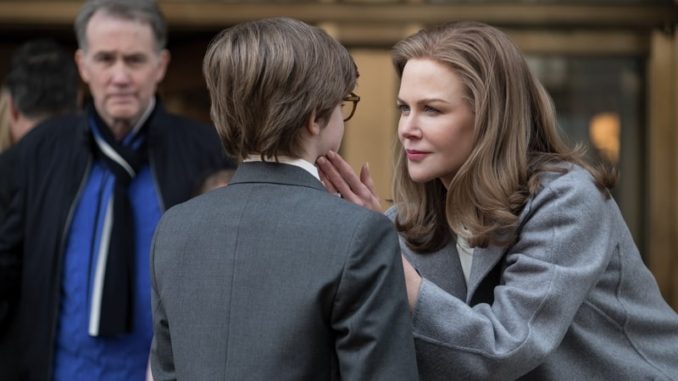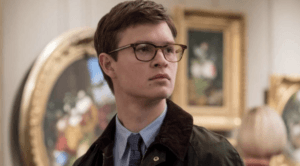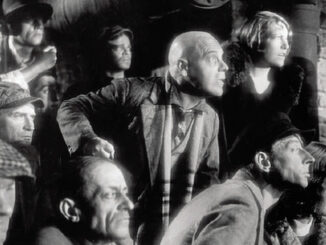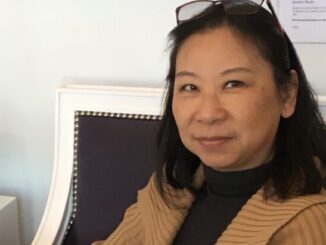
by Patrick Z. McGavin
“The Goldfinch” represents an auspicious feature debut for editor Kelley Dixon, ACE.
Warner Bros.’ new movie, opening Friday, is an adaptation of Donna Tartt’s Pulitzer Prize-winning 2013 novel, about the spiritual journey of a young man unmoored by his mother’s death in a terrorist bombing at the Metropolitan Museum of Art in New York.
Dixon is best-known for her exceptional work on the iconic cable series, “Breaking Bad.” She cut 27 episodes during the acclaimed show’s six-year run. In 2013, she received an Emmy for single-camera picture editing for the episode, “Gliding Over All.” She also worked on the “Breaking Bad” spin-off, “Better Call Saul.” Born in Chicago, Dixon spent her formative teenage years in Birmingham, Ala., and attended college at Colorado State.
“The Goldfinch” is the first studio film by the gifted Irish director John Crowley, who made the Academy Award-nominated “Brooklyn” (2015).
Told in flashback, the movie cuts between two dominant time periods in exploring the emotional inner life of Theo Decker, who’s played as a young man by Ansel Elgort (and as a boy by Oakes Fegley). The title refers to the painting by the 17th century Dutch master Carmel Fabritius, which Theo unexpectedly comes to possess, and the artwork becomes an important metaphor for the boy’s journey.

In an exclusive interview, Dixon talked about the challenges of shaping Tartt’s complex, Dickensian novel into a film, her personal connection to the film, and her early experiences working for Quentin Tarantino. (Warning: Some mild spoilers follow.)
CineMontage: What was your preparation on the project? Did you read the novel?
Kelley Dixon: My agent sent me the script when they said they wanted to interview me. I was embarrassed because I never heard of [the novel], and I am a reader. When I found out it was 771 pages, I realized there was no way I could read that in a weekend. I got the audio book. I started listening on a Friday on my way home from work, and I read the script the next morning over breakfast and I continued the audio book because I knew they probably wanted to talk with me on Monday.
What was your process like with the director, John Crowley? Was he in the room with you?
Dixon: He started shooting on January 23rd, 2018 and he finished around April 28th. He did not come in to see the final assembly until May 14. We would meet up every Sunday if he was in town, and he would look at the scenes I cut through the week. He wouldn’t really give notes. He would just give ideas: “Yes, I like what you are doing,” or “I had this other intention here.” He gave me free reign to do what I wanted as an editor.
Once he started his cut in May, we worked until about October. We’d work every day, sometimes on Saturday, eight to ten hours a day. A lot of our time, probably about a third was spent in discussion about the narrative. The narrative is very dense and packed with plot and metaphors. A lot of it was about discussion and about how we felt about certain things. Sometimes he’d work on scenes with me, and a lot of times, he would talk about certain conceptual things and he’d go off for an hour or so and I’d just work on it by myself.
The movie’s narrative is very complex. Were you hired because of your experience on long-form programs like “Breaking Bad”?
Dixon: I never had that discussion with [John]. I have always been very curious about why he hired me. The idea of me getting a big feature like this is so crazy and unheard of. It doesn’t usually happen, and I did not expect it.
I was very well prepared when I spoke to him originally about the movie. I feel like a lot of my success was because I read the book and I really digested the material and I was on top of the narrative. A lot of our discussion and the way we worked, so much of our conversation was about the deep dive into the metaphors and characterizations and everything that was going on, what the boy felt and all that.
The novel is nearly 800 pages, and even though the film runs two and a half hours, I am sure you had to make a lot of tough choices.
Dixon: A lot. It was very, very hard.
Was it difficult to reconcile the urge to honor the novel, which has many devoted fans, but also create a film that could stand on its own?
Dixon: I think the lion’s share of the work was done in the script. John and Peter Straughan, the writer, worked very hard on the script. They made a lot of structural decisions. They decided to make some chronological changes in the narrative from the book. They set the stage for the jumps in time, going back and forth to Las Vegas. They made those decisions. When we got into the room, I cut the editor’s cut in the script order. We started making changes from there. It was very long, much longer [than the finished film]. We had to lift many things, many parts of scenes, many characters had to be trimmed a lot just because of time. It’s such a massive piece of work.
They basically gave us the blueprint, Peter and John, on which to work and we pretty much stayed within that blueprint, but there might be a scene with [Theo’s mentor] Hobie (Jeffrey Wright) where Theo is learning the woodworking, the script order jumped a little bit ahead of the movie. We still had the jumps in time and they always existed.
The movie has three blocks of time, with Theo as a 13-year old, Theo as a young man and Theo in the present day material in Amsterdam. Did you and John try to alter the editing rhythms to fit those different time frames?
Dixon: The Amsterdam hotel room was always a section within itself. That is the present and beyond, and from there we move forward. From that spot, that is remembering or going back in time with Theo. All of that has a very different feel, editing-wise, to the different stuff. The 13-year old Theo, there is unplaced guilt, he doesn’t really know how to manage, his mother has basically disappeared. There was never a memorial or anything. She is just gone. The only thing he can remember is her walking away from him. That has a different feel, he’s alone but also coming into his own, with his friend, Boris (played by the actors Finn Wolfhard and Aneurin Barnard).
As a young man, he is formed and made decisions about how he is going to live his life, a little on the devious side, always making sure he is not showing vulnerability and trying to be in control, but obviously the monkey on his back, which is the painting he is holding onto, manifesting itself and hurting him from the inside.
One thing I always talked with John about is, this guy has not really grown up yet. My mother died when I was 14 years old, certainly not as violently as the mother here. I recognized early on what this kid was going through and how he felt. One of the things I said to John, when that happened to me, it’s like you become a perpetual visitor. You are always visiting. You are never really home again until you make your own home. I mentioned to John, he still not over this because he’s grown and he is still living with Hobie. He has not really gone and made his own place in the world.

Like the novel, Theo is the narrator and protagonist. Apart from his voiceover, were there formal ways through the editing you wanted to emphasize his subjectivity?
Dixon: When I read a script, I see it in my head. The script was fairly illustrative and I would see in my head the way it worked. I would get footage, I hope it is the same as what I see in my head, but often it is not. What I have to do is take that footage and do what I can with it to make something that touches my heart the way that script did. I know that sounds probably odd and a little obscure, but that is the way I approach it. I guess my answer is that I don’t think I had a very different approach.
You have two different actors playing the same character at different stages of his life. Were there specific ways you and John wanted to link these two different actors?
Dixon: I do not think I ever thought about it as a very conscious thing. It was a subconscious thing. The circumstances of the two time periods are very different. As a kid, he is basically thrust into something so involuntarily he has to react to everything thrown at him. He is also dealing with the guilt, tragedy, and sadness. People when they are very young, they don’t know how to help him. You really feel for him. The scenes of Theo as younger are so much more quieter.
The scenes when he is older, he is much more active. He is really the one who is moving through and making the decisions. There are not a lot of moments of reflection. When he is younger, he has no control. When he is older, he is having to maintain control, because if he doesn’t he ends like the scene in the storage locker, doing drugs and not even sure where he is or what is going on.
One thing we did that we found very effective was juxtaposing the boy with the man. I don’t think it was ever written that way, and we came up with ways to have him remember a memory, we cut to him as a kid, and that helps us an audience remember and have some empathy for what is going on.
Obviously you have spent a lot of time with this material. By the time you and John Crowley finished, was there a sense of relief and exultation, or did you want to just stay with this material?
Dixon: We worked on a long time on this. There is so much material and so many things you wish you could keep, things that we both felt that were so important that we had to let go of. That part [of filmmaking] is always very difficult. I also felt like it landed on its course organically. I wanted to make changes this summer. I still have thoughts [of], “I didn’t think to try this then, but maybe this would work and maybe we should go back in and try it.”
I don’t usually feel that way about anything else I worked on, but with this one, there was so much to try to get in there. It is almost as if, you want to sit here and see if you can get an understanding out of something, but take less time to do it, or something like that. For me, it’s not about time, but on the other hand, it is. You don’t want to pack in things. On the other hand, you want the pacing to be done well, but it’s so hard because there is so much there, so many parts to the story, plot twists in the narrative.
I told friends last year, you could do a whole movie just on Vegas. You could do a whole movie about this kid losing his mother and not deal with the painting at all. You could do a whole movie on just how the painting has been moved around. There are so many plot pieces to this thing, and trying to get them all together and also follow the internal emotional story is just massive. I am constantly thinking, “Is there a way I could have shown what Theo is thinking here? I wish I had tried that,” even now.
This is your first feature as an editor. What a debut.
Dixon: Yeah, I feel kind of mixed about it. I feel a little sad it has not been as well-received as we all had hoped. It’s very tough. I am hoping that no one felt that they made a bad decision. I am very proud of the work that I did. I had to move to New York City for a year, and it was a great adventure. I feel like I stretched as an editor, and I had a really wonderful experience with John Crowley and the rest of my crew. I really enjoyed it, and I can’t wait to do more.
I used to talk with friends of mine who were feature editors, and I used to think, “What in the world do you do for months and months? In television, we are pretty much done with an episode in about a month!” I had a great time. It was amazing the amount of time you had. We really needed that amount of time to really just wrestle with this thing and figure out how to put it on the screen. Like I said, I have ideas for changes even now.
Did you go to film school? How did you gravitate toward editing?
Dixon: I went to school in Fort Collins, Colorado. I wanted to write ad copy. When I came to California, I could not get into any advertising company mailrooms, so I got into the mailroom at MGM. Six months later, I was a production assistant. I just started hanging out in editing. I had done some editing in school. I was a journalism major. I knew a little bit about it, and I liked it. I always thought, if your parents weren’t in the movies, then you’d never be in the movies. I never thought you could just get into films. Coming from Chicago and then spending three years in high school in Alabama, it was so ridiculous to think about film school.
One of your first jobs was as an assistant on “Reservoir Dogs.” What was that like?
Dixon: I get this question a lot. My experience with “Reservoir Dogs” is not really what everybody thinks. I was approached at the very end to help with a bunch of opticals and get the negative cut done. At that point, (editor) Sally Menke, (director) Quentin Tarantino and (producer) Lawrence Bender, they were all on the mix stage and I was pretty much by myself, handing the different versions of the ear [torture sequence] to get the MPAA rating and get the negative cut done and opticals finalized for Sundance.
I think it was a lot of people’s first job. It was a very low, low budget movie. Sally approached me in the summer of that year to do the movie as a first assistant, and I said there was no way I was in any position to be a first assistant. I knew how to do it, but I had never done it. Being a first assistant on a film is a very hard job.
How would you say your ideas about style and form have evolved during your time?
Dixon: When I first started out, probably like a lot of other people, you are just trying to understand what the producers or filmmakers want from you, and you are trying to make a very clean cut. Hopefully you get to be a little artistic. I found that I moved from being artistic and being creative and from there, try to hone my instincts a little bit.
Now I find I am thinking a lot about the material, the narrative, where the audience is at any given time. Are they connected with any one character, our main character, or is the audience sitting in a more subjective position? If that is the case, is that what we want as filmmakers? I am doing a deep dive where the audience is and where I want them to be and the amount of understanding I want them to be at any given time.
One of the things I discussed with John: We had a long discussion about when Theo was a young boy. I asked John, “Do you think Theo as a boy understands what the painting means at this point, that it is a symbol of surviving and his mother?” John thought about it and he said, “No, I don’t think that he knows what that is. There are all kinds of other things he is dealing with. Taking care of that painting, he just knows that he can’t let it go because he doesn’t have an understanding.” I said, “Do you think as an audience we are aware that we are ahead of Theo at that point?” He thought about it, and he said, “Yes.”
I think that is a small example of the kind of work I am doing in my head and in my work. I am looking at what is going on with the audience, because that is something that I have a lot of control over as an editor.
Patrick Z. McGavin is a Chicago-based film critic and cultural journalist. His writing on film has previously appeared in the Chicago Reader and RogerEbert.com. His recent interview subjects for CineMontage include Fred Raskin and Laura Weinberg.





